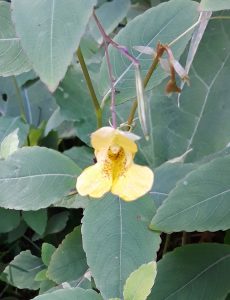Pale Touch-me-not
Impatiens pallida grows along lakeshores, riverbanks and moist thickets July into September. Plant height is 2 to 6 feet. It’s cousin, spotted touch-me-not has orange flowers. Both species are very similar except that pale touch-me-not grows a bit larger, tends to have larger leaves that are more finely toothed, and has larger flowers with a shorter spur at the back. This species is also known as yellow jewelweed.
Both jewelweed and yellow jewelweed are annuals, and as such they can only reproduce by reseeding each year. To ensure this happens, they have both a plan AND a backup plan! The main way is for the funnel-shaped, nectar filled flowers to entice pollinators such as bees and hummingbirds inside. When the flower first opens, the male parts (stamens) mature first and produce pollen; then they wither and the female parts take over (the pistils) ready for visitors to brush them with pollen on their way in and out as they go from flower to flower. Thus, cross-pollination is accomplished in this lively and ingeniously effective way! While I was visiting one day, I laughed to see a bee completely disappear inside a tube to sip nectar. Being the same length as the flower, only the fuzzy tip of his behind showed until the bee backed out again!
Jewelweed’s backup plan is both interesting and foolproof. Besides the attractive flowers, the plant also forms very inconspicuous (about 1 mm long) flowers that never open. These flowers (called cleistogamous) fertilize themselves and form their own seeds inside. (The plants that grow from these cleistogamous flowers are not as hardy, but in lean years it’s better than nothing.)
Medicinally useful, the juice from jewelweed’s crushed stems rubbed onto skin will help alleviate symptoms of poison ivy and other rashes. This is because it contains a compound called lawsone, which has antihistamine and anti-inflammatory properties.
This beautiful flower gets its name from the fact that in autumn when the fruiting seed pods ripen and dry, they will explode at the slightest touch sending the seeds shooting out! Another lively way this plant can play upon the human imagination and encourage fun, hands on learning. So, actually, “yes, please do touch me”!

